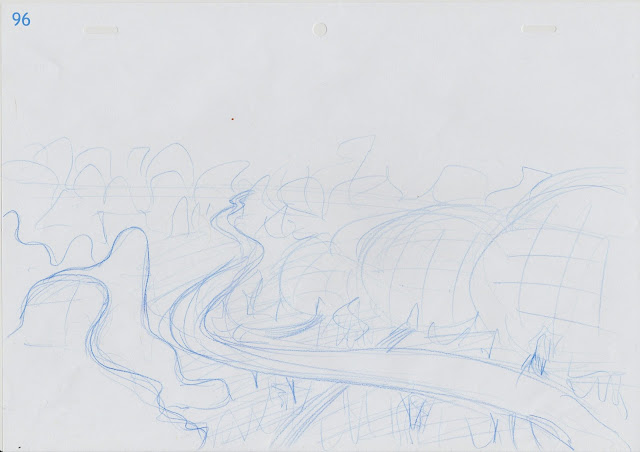 |
| Fig. 1 Poster |
Designed by Alfred Junge, a regular collaborator on films by Powell and Pressburger, the entire film was shot in England, with almost all of it shot at Pinewood Studios, and a small part of the film - the gardens - shot at Leonardslea in West Sussex (Howells, 2011). Matte painting was used to create the backdrop for the film, which is set in the Himalayas of India. The differences between Fig. 2 and Fig. 3 show just how much of the landscape seen in the film was produced through this technique. The effect is incredible, and, according to Peter Bradshaw, writing in 2005, 'the sets and backdrops are superbly and still convincingly rendered' (Bradshaw, 2005).
 |
| Fig. 2 Integrated Matte Painting |
 |
| Fig. 3 Behind the Scenes |
 |
| Fig. 4 The Confrontation |
 |
| Fig. 5 Intense Lighting |
 |
| Fig. 6 The Nuns |
 |
| Fig. 7 Sister Ruth and Mr Dean |
Bibliography
Bradshaw, P (2005). Black Narcissus. At: https://www.theguardian.com/theguardian/2005/aug/05/3 (Accessed on 26.11.16)
Ede, L (2010). British Film Design: A History. London: I.B. Tauris & Co Ltd. [Online] At: https://books.google.co.uk/books?id=7633AgAAQBAJ&pg=PA54&lpg=PA54&dq=black+narcissus+set+design&source=bl&ots=0TxvgDP_-B&sig=Mth9uxm87knOkBELs6_iU_lWZpY&hl=en&sa=X&ved=0ahUKEwj_sIv9qavQAhVFI8AKHVJSDEw4ChDoAQg4MAY#v=onepage&q&f=false (Accessed on 26.11.16)
Howells, M (2011). Behind the Mask: Production Design in Black Narcissus. At: http://guru.bafta.org/behind-mask-production-design-black-narcissus (Accessed on 26.11.16)
Mirasol, M (2010). "Black Narcissus," Which Electrified Scorsese. At: http://www.rogerebert.com/far-flung-correspondents/black-narcissus-which-electrified-scorsese (Accessed on 26.11.16)
Pryor, T (1947). Black Narcissus. At: http://www.nytimes.com/movie/review?res=EE05E7DF173CE261BC4C52DFBE66838C659EDE (Accessed on 26.11.16)
Illustration List
Fig. 1 Poster
Powell, M and Pressburger E (1947). 'Black Narcissus'. [Poster] At: http://assets.flicks.co.nz/images/movies/poster/70/70afbf2259b4449d8ae1429e054df1b1_500x735.jpg (Accessed on 26.11.16)
Fig. 2 Integrated Matte Painting
Powell, M and Pressburger E (1947). 'Black Narcissus'. [Film Still] At: https://blogger.googleusercontent.com/img/b/R29vZ2xl/AVvXsEjWJ5zi45Nu__QKrkzRBKLLUcffNSP0Onz0x3bTqBYxeh839ByDD4jds7-3VwowPqbjDI3GjIm638QPu_wV9oKQHt8o8_a_opNw3owuPr0js8vENlogu2NjLnpKTTFIu_vLEGwD2ni65ok/s1600/black-narcissus.jpg (Accessed on 26.11.16)
Fig. 3 Behind the Scenes
Powell, M and Pressburger E (1947). 'Black Narcissus'. [Behind the Scenes Photgraph] At: http://theredlist.fr/media/database/settings/cinema/1940-1950/the-black-narcissus/007-the-black-narcissus-theredlist.jpg (Accessed on 26.11.16)
Fig. 4 The Confrontation
Powell, M and Pressburger E (1947). 'Black Narcissus'. [Film Still] At: https://www.berlinale.de/media/filmstills/2015_1/retrospektive_11/201520114_4_IMG_FIX_700x700.jpg (Accessed on 26.11.16)
Fig. 5 Intense Lighting
Powell, M and Pressburger E (1947). 'Black Narcissus'. [Film Still] At: http://theredlist.fr/media/database/settings/cinema/1940-1950/the-black-narcissus/007-the-black-narcissus-theredlist.jpg (Accessed on 26.11.16)
Fig. 6 The Nuns
Powell, M and Pressburger E (1947). 'Black Narcissus'. [Film Still] At: http://networkonair.com/features/wp-content/uploads/2014/07/blacknarcissus01.jpg (Accessed on 26.11.16)
Fig. 7 Sister Ruth and Mr Dean
Powell, M and Pressburger E (1947). 'Black Narcissus'. [Film Still] At: https://s-media-cache-ak0.pinimg.com/736x/1d/d6/ba/1dd6baec2b90d28613a3c832c5226b8f.jpg (Accessed on 26.11.16)
Fig. 8 Red Lipstick
Powell, M and Pressburger E (1947). 'Black Narcissus'. [Film Still] At: http://image.glamourdaze.com/2012/09/1940s-lipstick-Kathleen-Byron-in-Black-NarcissusB.jpg (Accessed on 26.11.16)
Bradshaw, P (2005). Black Narcissus. At: https://www.theguardian.com/theguardian/2005/aug/05/3 (Accessed on 26.11.16)
Ede, L (2010). British Film Design: A History. London: I.B. Tauris & Co Ltd. [Online] At: https://books.google.co.uk/books?id=7633AgAAQBAJ&pg=PA54&lpg=PA54&dq=black+narcissus+set+design&source=bl&ots=0TxvgDP_-B&sig=Mth9uxm87knOkBELs6_iU_lWZpY&hl=en&sa=X&ved=0ahUKEwj_sIv9qavQAhVFI8AKHVJSDEw4ChDoAQg4MAY#v=onepage&q&f=false (Accessed on 26.11.16)
Howells, M (2011). Behind the Mask: Production Design in Black Narcissus. At: http://guru.bafta.org/behind-mask-production-design-black-narcissus (Accessed on 26.11.16)
Mirasol, M (2010). "Black Narcissus," Which Electrified Scorsese. At: http://www.rogerebert.com/far-flung-correspondents/black-narcissus-which-electrified-scorsese (Accessed on 26.11.16)
Pryor, T (1947). Black Narcissus. At: http://www.nytimes.com/movie/review?res=EE05E7DF173CE261BC4C52DFBE66838C659EDE (Accessed on 26.11.16)
Illustration List
Fig. 1 Poster
Powell, M and Pressburger E (1947). 'Black Narcissus'. [Poster] At: http://assets.flicks.co.nz/images/movies/poster/70/70afbf2259b4449d8ae1429e054df1b1_500x735.jpg (Accessed on 26.11.16)
Fig. 2 Integrated Matte Painting
Powell, M and Pressburger E (1947). 'Black Narcissus'. [Film Still] At: https://blogger.googleusercontent.com/img/b/R29vZ2xl/AVvXsEjWJ5zi45Nu__QKrkzRBKLLUcffNSP0Onz0x3bTqBYxeh839ByDD4jds7-3VwowPqbjDI3GjIm638QPu_wV9oKQHt8o8_a_opNw3owuPr0js8vENlogu2NjLnpKTTFIu_vLEGwD2ni65ok/s1600/black-narcissus.jpg (Accessed on 26.11.16)
Fig. 3 Behind the Scenes
Powell, M and Pressburger E (1947). 'Black Narcissus'. [Behind the Scenes Photgraph] At: http://theredlist.fr/media/database/settings/cinema/1940-1950/the-black-narcissus/007-the-black-narcissus-theredlist.jpg (Accessed on 26.11.16)
Fig. 4 The Confrontation
Powell, M and Pressburger E (1947). 'Black Narcissus'. [Film Still] At: https://www.berlinale.de/media/filmstills/2015_1/retrospektive_11/201520114_4_IMG_FIX_700x700.jpg (Accessed on 26.11.16)
Fig. 5 Intense Lighting
Powell, M and Pressburger E (1947). 'Black Narcissus'. [Film Still] At: http://theredlist.fr/media/database/settings/cinema/1940-1950/the-black-narcissus/007-the-black-narcissus-theredlist.jpg (Accessed on 26.11.16)
Fig. 6 The Nuns
Powell, M and Pressburger E (1947). 'Black Narcissus'. [Film Still] At: http://networkonair.com/features/wp-content/uploads/2014/07/blacknarcissus01.jpg (Accessed on 26.11.16)
Fig. 7 Sister Ruth and Mr Dean
Powell, M and Pressburger E (1947). 'Black Narcissus'. [Film Still] At: https://s-media-cache-ak0.pinimg.com/736x/1d/d6/ba/1dd6baec2b90d28613a3c832c5226b8f.jpg (Accessed on 26.11.16)
Fig. 8 Red Lipstick
Powell, M and Pressburger E (1947). 'Black Narcissus'. [Film Still] At: http://image.glamourdaze.com/2012/09/1940s-lipstick-Kathleen-Byron-in-Black-NarcissusB.jpg (Accessed on 26.11.16)













































